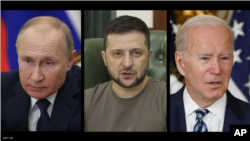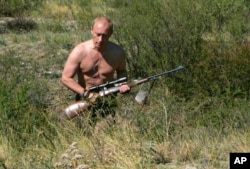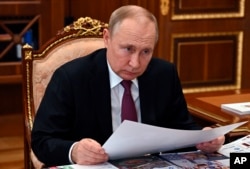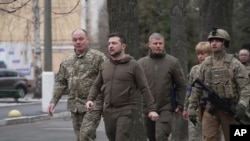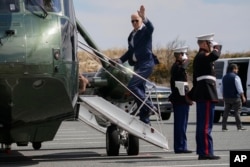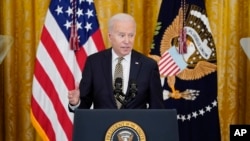The ideologue. The charismatic leader. The pragmatist.
The key players in the Ukraine conflict — Russian President Vladimir Putin, Ukrainian President Volodymyr Zelenskyy and U.S. President Joe Biden — represent three distinct leadership styles, according to Samuel Hunter of the University of Nebraska at Omaha.
“It doesn't always happen that you have one of each. Often, you have the same styles kind of bumping heads with one another,” says Hunter, a professor of industrial and organizational psychology. “But in this scenario, you have one of each of the three styles on a world stage.”
There are multiple pathways to leadership, according to Hunter, and no single perfect way to lead.
The ideologue
Putin is an ideological leader. Psychiatrist Kenneth Dekleva, a senior fellow at the George H. W. Bush Foundation for U.S.-China Relations, has studied the ex-KGB agent (foreign intelligence and domestic security agency for the Soviet Union) for 20 years.
“He's a ruthless, authoritarian leader who has carried out ruthless acts over the past two decades,” Dekleva says. “Until the Ukraine invasion, it was fair to consider him a brilliant tactician and strategist.”
Putin has cultivated the image of a physically fit man-of-action, releasing pictures of himself posing topless on horseback, spearfishing, carrying a rifle, flipping an opponent while practicing martial arts and purportedly wrestling a bear.
“Putin represents a much more familiar and old-fashioned style of leadership in that he presents himself as uniquely strong and uniquely touched by destiny,” says Michael Blake, a professor of philosophy, public policy, and governance at the University of Washington.
“He presents himself as capable of defeating others, of judiciously deploying cruelty and other forms of political skill, and also as unique in his ability to return Russia to a golden age in its past. And that image of the leader is an extremely common one in political history. It's associated with fascism, but it's not unique to fascism,” Blake says.
One of Putin’s driving motivations is to restore Russia to the former glory it enjoyed as the Soviet Union, which was a global powerhouse until it collapsed in 1991.
“Ideological leaders often are more backward-looking,” Hunter says. “So, there's a bygone era that they either wish existed or hope to return to. That's really the goal, which is they would like to go back to a previous era. In the specific case of Putin, return to the Soviet-era Russia, where there was more power and influence on a global stage with regard to Russian influence.”
Charismatic leader
Zelenskyy has emerged as a charismatic leader. The former actor and comedian surprised many with his courage and determination after Russia invaded his country on February 24.
“Charismatic leaders are personified in a number of different ways. But a couple of things that characterize them are this sentiment of hope, that sentiment of change, often, [and] not always but often positive emotion, talking about a brighter future and enacting change to make things better,” Hunter says. “And so, in many ways, Zelenskyy captures that with appeal to a wide audience, appealing to the masses and a broad message.”
While Putin seems to be following a familiar playbook, Zelenskyy is demonstrating the viability of a new one, according to Blake.
“Zelenskyy appears to be presenting a much more unusual picture of leadership in which his trajectory is not ordained by fate or some sort of political genius,” Blake says. “Instead, it's almost accidental. His personal style of self-presentation is much less concerned with depicting unusual lack of fear or unusual physical prowess. Instead, he is perfectly willing to own up to being frightened and being occasionally overwhelmed.”
Given Zelenskyy’s entertainment background, many underestimated the political novice. Yet he has managed to rally his people to rise up against the Russian attack. When the United States offered to evacuate the Ukrainian leader and his family, Zelenskyy famously refused, reportedly saying, “The fight is here. I need ammunition, not a ride.”
“I think the Russians and the West and even the United States got Zelenskyy wrong,” says Dekleva, the Bush foundation fellow. “I think we assumed that Zelenskyy was a lightweight … that he would flee. And had he done so, I don't think we'd be having this conversation today. I think he had an epiphany when the invasion started, and he made a decision that resonates with the world.”
The pragmatist
Biden, who has led the West’s response to the Russian attack on Ukraine, is an example of a pragmatic leader.
“Biden represents the pragmatic pathway,” Hunter says. “Pragmatic leaders are all about problem-solving. They're often very rational, data driven, by the numbers. And in many ways, pragmatic leaders are boring.”
Biden has been in politics since 1972, when he was first elected to the U.S. Senate. He was reelected six times before leaving to serve as President Barack Obama’s vice president for eight years.
“Joe Biden represents everything that has been precedented. He's an old-fashioned Democratic leader,” Blake says. “He is less concerned with presenting himself as unique, as embodying destiny, or as presenting cruelty as a presumptive political good. And in this, I think, he has a certain aspect of some of Zelenskyy’s virtues. But he has also had much less occasion to demonstrate their depth.”
When it comes to Ukraine, much of Biden’s focus has been on taking a measured approach in protecting U.S. interests, while staying at arm’s length from the conflict itself.
“A lot of this is keeping the temperature down or keeping emotion out of it. Pulling a lot of levers behind the scenes. Making sure that allies and networks are built, using things like economic sanctions, as opposed to, hopefully, military kinds of interventions from the U.S. side,” Hunter says.
The outcome
A major crisis can amplify or define a politician’s leadership style.
“We can be very guarded and measured and collected most of the time, but during crises, you're under time pressure and stress,” Hunter says. “All these things combined to make it much more difficult to self-regulate, and who you really are will emerge. … If it’s enough of that pressure, you'll start to see who these leaders really are.”
The types of leaders involved in a conflict can dictate what sort of resolution is required. In Putin’s case, that would require a technique called tactical empathy, Dekleva says.
“We’re in a very, very delicate, dangerous situation now where Putin is cornered. He's suffered a loss of prestige. He’s now a pariah, and he’s boxed in a corner. That's a dangerous Putin,” Dekleva says. “I think we have to be very careful and provide, diplomatically, what's called an off-ramp or a way for them to de-escalate and make Putin feel — internally to himself and propagandistically — … that he's achieved his objectives and can save face and back off from this war.”




